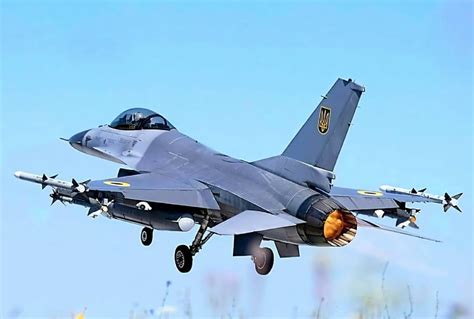
A Ukrainian F-16 fighter jet has reportedly achieved its first confirmed aerial victory, downing a Russian warplane in combat, marking a significant milestone in Ukraine’s efforts to defend its airspace.
Ukraine has successfully deployed the F-16 Fighting Falcon, resulting in the downing of a Russian fighter jet, marking the aircraft’s first confirmed combat kill in Ukrainian service. While specific details about the engagement remain limited, this event marks a notable success for the Ukrainian Air Force and a potential turning point in the aerial conflict with Russia. The downing of the Russian jet underscores the impact of advanced Western weaponry in bolstering Ukraine’s defense capabilities. This development could potentially shift the balance of power in the skies, impacting future military operations.
Details of the Engagement
The specifics surrounding the downing of the Russian jet are still emerging. At present, neither the Ukrainian Ministry of Defense nor independent sources have released comprehensive details of the aerial engagement. Information regarding the type of Russian aircraft involved, the location of the incident, and the specific tactics employed by the Ukrainian pilot are not yet publicly available. As more information becomes available, a clearer picture of the circumstances surrounding this event will likely emerge. It’s worth noting that in modern warfare, the dissemination of precise details related to military operations often occurs with a deliberate delay to safeguard operational security and prevent the adversary from gaining tactical advantages.
Implications for the Air War
The reported downing of a Russian jet by a Ukrainian F-16 carries significant implications for the ongoing air war. Prior to the arrival of the F-16s, the Ukrainian Air Force relied primarily on Soviet-era aircraft, which were often outmatched by more modern Russian fighters. The introduction of the F-16, with its advanced radar, weaponry, and electronic warfare capabilities, provides Ukraine with a qualitative edge in aerial combat. This event also serves as a clear signal to Russia that Ukraine now possesses a more formidable air defense capability, potentially deterring future Russian air operations. The psychological impact of this success on both sides should not be underestimated, as it boosts Ukrainian morale and confidence while potentially causing Russia to reassess its tactics and strategies.
Ukraine’s Acquisition of F-16s
The acquisition of F-16 fighter jets by Ukraine represents a pivotal development in its defense strategy. For months, Ukrainian officials have lobbied Western allies for the advanced aircraft, arguing that they are essential for countering Russian air superiority. Several European countries, including the Netherlands, Denmark, and Norway, pledged to donate their F-16s to Ukraine, pending the completion of necessary training and logistical preparations. The transfer of these aircraft is a complex undertaking, involving not only the physical delivery of the jets but also the training of Ukrainian pilots and maintenance personnel, as well as the establishment of a robust supply chain for spare parts and ammunition.
Training and Integration
The successful integration of the F-16 into the Ukrainian Air Force depends heavily on the quality and extent of the training provided to Ukrainian pilots and ground crews. Training programs, primarily conducted in European countries, focus on familiarizing Ukrainian personnel with the F-16’s advanced systems and operational procedures. The curriculum typically includes classroom instruction, simulator training, and live flying exercises. Additionally, Ukrainian technicians receive specialized training in the maintenance and repair of the aircraft. The effectiveness of this training will be crucial in determining the F-16’s combat readiness and its ability to effectively engage Russian aircraft. Integrating these new aircraft into an existing air force structure that primarily uses older Soviet-era equipment poses substantial challenges regarding maintenance, logistics, and operational compatibility.
Challenges and Limitations
Despite the potential benefits of the F-16, Ukraine’s Air Force still faces numerous challenges. The number of F-16s being supplied is relatively limited, and it will take time to fully integrate them into the existing air force structure. Furthermore, Russia possesses a significant numerical advantage in terms of aircraft and air defense systems. The F-16, while advanced, is not invulnerable and can be targeted by Russian air-to-air missiles and surface-to-air missile (SAM) systems. The availability of spare parts and maintenance support could also become a limiting factor, particularly in the event of sustained combat operations. Ukraine’s ability to operate and maintain the F-16 effectively will depend on continued support from its Western allies.
The F-16 Fighting Falcon: A Technical Overview
The F-16 Fighting Falcon is a multirole fighter jet developed by General Dynamics (now Lockheed Martin) in the 1970s. It is renowned for its agility, versatility, and advanced avionics. The F-16 is equipped with a powerful radar system capable of detecting and tracking targets at long ranges. It can carry a wide array of air-to-air and air-to-ground weapons, including AIM-9 Sidewinder and AIM-120 AMRAAM missiles, as well as various bombs and rockets. The F-16’s electronic warfare suite provides protection against enemy radar and electronic countermeasures. Its high thrust-to-weight ratio and advanced flight control system give it exceptional maneuverability in air combat. The F-16 has been widely exported and is currently in service with numerous air forces around the world.
The Geopolitical Context
The downing of the Russian jet by a Ukrainian F-16 occurs within the broader geopolitical context of the ongoing conflict between Russia and Ukraine. The war, which began in 2014 with Russia’s annexation of Crimea and support for separatists in eastern Ukraine, escalated dramatically in February 2022 with Russia’s full-scale invasion. Western countries have responded by imposing sanctions on Russia and providing military and financial assistance to Ukraine. The provision of F-16 fighter jets to Ukraine is part of this broader effort to bolster Ukraine’s defense capabilities and deter further Russian aggression. The conflict has had far-reaching consequences, not only for Russia and Ukraine but also for the international security order.
Western Response and Support
The response from Western countries to the reported downing of the Russian jet has been largely supportive of Ukraine. Western officials have praised Ukraine’s resilience and determination in the face of Russian aggression, and they have reiterated their commitment to providing Ukraine with the assistance it needs to defend itself. The provision of F-16 fighter jets is seen as a tangible demonstration of this support. However, some Western officials have also cautioned against escalating the conflict, emphasizing the importance of diplomacy and de-escalation.
Russian Reaction
The Russian government has not yet officially commented on the reported downing of its jet by a Ukrainian F-16. However, Russian state media outlets have downplayed the significance of the event, suggesting that it is merely a propaganda stunt designed to boost Ukrainian morale. Some Russian commentators have also questioned the effectiveness of the F-16, claiming that it is easily vulnerable to Russian air defense systems. It is likely that the Russian military is closely analyzing the circumstances surrounding the incident to determine what lessons can be learned and what countermeasures can be taken.
Potential Future Developments
The downing of the Russian jet could have several potential implications for the future of the conflict. It could embolden Ukraine to conduct more offensive air operations, potentially targeting Russian military assets and infrastructure. It could also prompt Russia to intensify its own air operations, seeking to degrade Ukraine’s air defenses and neutralize the F-16 threat. The conflict could also escalate if either side miscalculates or takes actions that are perceived as escalatory by the other side. The situation remains highly volatile, and the risk of further escalation remains significant.
Impact on the War’s Trajectory
The downing of a Russian jet by a Ukrainian F-16 could significantly impact the war’s trajectory by altering the balance of power in the skies. Prior to the introduction of the F-16, Russia enjoyed a clear advantage in aerial warfare, allowing it to conduct bombing raids and provide close air support to its ground forces with relative impunity. The F-16, with its advanced radar and weaponry, has the potential to challenge this dominance, forcing Russia to reconsider its air operations and potentially reducing its ability to conduct effective ground attacks. This shift in the air war could have a cascading effect on the ground war, making it more difficult for Russia to achieve its military objectives.
Ukraine’s Strategic Advantages
The deployment of the F-16 by Ukraine confers several strategic advantages. These include:
-
Enhanced Air Defense: The F-16 significantly enhances Ukraine’s ability to defend its airspace against Russian air attacks, protecting critical infrastructure and population centers.
-
Increased Offensive Capabilities: The F-16 enables Ukraine to conduct more effective offensive air operations, targeting Russian military assets and disrupting supply lines.
-
Improved Reconnaissance and Surveillance: The F-16’s advanced sensors and reconnaissance capabilities allow Ukraine to gather better intelligence on Russian troop movements and deployments.
-
Deterrent Effect: The presence of the F-16 serves as a deterrent to Russian aggression, making Russia think twice before launching new attacks or escalating the conflict.
Russia’s Countermeasures
In response to the introduction of the F-16, Russia is likely to implement a range of countermeasures, including:
-
Strengthening Air Defenses: Russia will likely reinforce its air defenses in the areas where the F-16 is operating, deploying additional surface-to-air missile (SAM) systems and fighter jets.
-
Developing New Tactics: Russia will likely develop new tactics for engaging the F-16, seeking to exploit its weaknesses and minimize its effectiveness.
-
Electronic Warfare: Russia may increase its use of electronic warfare to disrupt the F-16’s radar and communications systems.
-
Targeting Airfields: Russia may attempt to target Ukrainian airfields where the F-16 is based, seeking to destroy the aircraft on the ground.
Long-Term Implications
The long-term implications of the Ukrainian F-16 deployment extend beyond the immediate conflict. The successful integration of the F-16 into the Ukrainian Air Force could serve as a model for other countries seeking to modernize their air forces and enhance their defense capabilities. It could also lead to increased demand for Western military equipment and training, further strengthening ties between Ukraine and its Western allies. The conflict has already had a profound impact on the geopolitical landscape, and the introduction of the F-16 is just one more factor that will shape the future of the region.
The Role of Technology in Modern Warfare
The conflict between Russia and Ukraine has highlighted the critical role of technology in modern warfare. From drones and precision-guided missiles to cyber warfare and electronic warfare, technology is playing an increasingly important role in determining the outcome of battles and conflicts. The F-16 is just one example of how advanced technology can be used to enhance military capabilities and gain a strategic advantage. As technology continues to evolve, it is likely to play an even greater role in future conflicts.
Psychological and Moral Impact
The downing of the Russian jet by a Ukrainian F-16 has a significant psychological and moral impact on both sides of the conflict. For Ukraine, it represents a much-needed boost in morale and confidence, demonstrating that it is capable of effectively defending itself against Russian aggression. For Russia, it is a setback that could undermine morale and raise doubts about the effectiveness of its military strategy. The psychological dimension of warfare is often underestimated, but it can play a crucial role in determining the outcome of conflicts.
The Importance of International Support
The conflict between Russia and Ukraine has demonstrated the importance of international support for countries facing aggression. Without the military and financial assistance provided by Western countries, Ukraine would have been unable to resist the Russian invasion. The provision of F-16 fighter jets is just one example of how international support can make a critical difference in the outcome of a conflict. As the world becomes increasingly interconnected, international cooperation and solidarity will be essential for maintaining peace and security.
Future of Aerial Warfare
The downing of the Russian jet raises important questions about the future of aerial warfare. The increasing sophistication of air defense systems and the proliferation of advanced fighter jets are making it more difficult to achieve air superiority. Future aerial conflicts are likely to be characterized by a greater emphasis on stealth technology, electronic warfare, and unmanned aerial vehicles (UAVs). The F-16, while still a capable aircraft, may eventually be replaced by more advanced fighter jets that are better suited to the challenges of the modern battlefield.
Conclusion
The reported downing of a Russian jet by a Ukrainian F-16 marks a significant milestone in the ongoing conflict. While the full implications of this event remain to be seen, it underscores the importance of advanced weaponry and the determination of the Ukrainian people to defend their country. As the conflict continues, it is essential that the international community remains united in its support for Ukraine and its efforts to achieve a just and lasting peace. The introduction of F-16s is more than just the introduction of a new weapon system, it symbolizes the ongoing support of Western allies and Ukraine’s ongoing determination to defend its sovereignty. It also highlights the rapidly evolving nature of modern warfare. The long-term impact of this event will be shaped by future developments on the battlefield and the broader geopolitical landscape.
Frequently Asked Questions (FAQ)
-
What type of Russian aircraft was shot down by the Ukrainian F-16?
- Specific details regarding the type of Russian aircraft downed by the Ukrainian F-16 have not been officially confirmed by either the Ukrainian Ministry of Defense or independent sources.
-
Where did the training of the Ukrainian pilots for the F-16 take place?
- Training programs for Ukrainian pilots on the F-16 are primarily conducted in European countries, as per the original article. The specific locations and the countries involved were not detailed in the original article.
-
Which countries have pledged to donate F-16s to Ukraine?
- According to the article, the Netherlands, Denmark, and Norway have pledged to donate their F-16s to Ukraine, pending the completion of necessary training and logistical preparations.
-
What are some of the key advantages that the F-16 provides to the Ukrainian Air Force?
- The F-16 offers several key advantages, including enhanced air defense capabilities, increased offensive capabilities, improved reconnaissance and surveillance, and a deterrent effect against Russian aggression, as detailed in the article.
-
What countermeasures might Russia take in response to the deployment of F-16s by Ukraine?
- Russia is likely to strengthen its air defenses, develop new tactics, increase its use of electronic warfare, and potentially target Ukrainian airfields where the F-16 is based, as described in the article.
Expanded Analysis and Contextual Information
Detailed Look at the F-16 Variant and its Capabilities for Ukraine:
It is essential to understand which specific variant of the F-16 Ukraine is receiving, as this significantly impacts its capabilities. The F-16 has undergone numerous upgrades and modifications throughout its production life. Some of the more relevant aspects include:
-
Radar Systems: Older F-16 variants might possess mechanically scanned radars, whereas newer models feature advanced Active Electronically Scanned Array (AESA) radars. AESA radars offer superior range, resolution, and the ability to track and engage multiple targets simultaneously. Knowing the radar type is crucial for evaluating its effectiveness against Russian aircraft.
-
Weapon Systems Compatibility: The range of weapons an F-16 can carry is also variant-dependent. The AIM-120 AMRAAM (Advanced Medium-Range Air-to-Air Missile) is a critical component for air-to-air combat, and its specific variant also matters. Newer versions of the AMRAAM have longer ranges and improved guidance systems. Likewise, the ability to employ advanced air-to-ground munitions significantly enhances the F-16’s versatility.
-
Electronic Warfare (EW) Suite: A modern EW suite is vital for survival in a contested airspace. The F-16’s EW capabilities can vary significantly, affecting its ability to detect, identify, and jam enemy radar and missile systems. A robust EW suite enhances survivability against sophisticated threats.
-
Data Links: Interoperability with other NATO assets through advanced data links like Link 16 is also essential. This allows the F-16 to share information with other aircraft, ground stations, and naval vessels, creating a more comprehensive picture of the battlefield. Without it, the F-16’s effectiveness is limited to what its own sensors can detect.
Understanding the specific F-16 variant and its associated capabilities is critical for accurately assessing its impact on the air war. The performance gap between older and newer F-16 models can be substantial, influencing their effectiveness against modern Russian aircraft and air defense systems.
The Broader Context of Western Military Aid to Ukraine:
The provision of F-16s should be viewed within the broader context of Western military aid to Ukraine. This aid encompasses a wide range of equipment, training, and logistical support designed to bolster Ukraine’s defense capabilities. Key elements of this aid package include:
-
Air Defense Systems: Systems like the Patriot, NASAMS, and IRIS-T provide crucial defense against Russian air attacks. These systems complement the F-16 by providing layered protection to critical infrastructure and population centers.
-
Artillery and Rocket Systems: HIMARS (High Mobility Artillery Rocket System) and other advanced artillery systems have enabled Ukraine to strike Russian supply lines and command centers with precision, disrupting their offensive operations.
-
Armored Vehicles: Tanks and infantry fighting vehicles provide Ukraine with the means to conduct offensive operations and defend against Russian armored assaults.
-
Training and Logistical Support: Western countries have provided extensive training to Ukrainian soldiers on the use of new equipment and tactics. Logistical support, including the supply of spare parts and ammunition, is essential for sustaining combat operations.
This comprehensive aid package has enabled Ukraine to resist the Russian invasion and maintain its sovereignty. The F-16 is a significant addition to this arsenal, but its effectiveness depends on the continued provision of other forms of military and financial assistance.
Impact on Russian Air Operations and Strategy:
The introduction of the F-16 will likely force Russia to adapt its air operations and overall military strategy. Some potential adaptations include:
-
Increased Reliance on Stand-off Weapons: Russia may increase its reliance on stand-off weapons, such as cruise missiles and long-range air-to-air missiles, to engage Ukrainian targets from outside the range of the F-16’s air defenses.
-
Enhanced Electronic Warfare Efforts: Russia may intensify its electronic warfare efforts to disrupt the F-16’s radar and communications systems, degrading its effectiveness in combat.
-
Improved Air Defense Integration: Russia may improve the integration of its air defense systems to create a more layered and resilient defense against Ukrainian air attacks.
-
Shifting Operational Focus: Russia may shift its operational focus to areas where the F-16 is less likely to operate, such as the eastern Donbas region.
These adaptations will require Russia to invest in new technologies and tactics, potentially straining its already stretched military resources. The introduction of the F-16 presents a significant challenge to Russia’s air power and will likely shape the future course of the conflict.
The Human Factor: Pilot Training and Operational Readiness:
The success of the F-16 deployment hinges on the quality and effectiveness of the training provided to Ukrainian pilots and ground crews. Several factors are critical for ensuring operational readiness:
-
Simulator Training: Extensive simulator training is essential for familiarizing pilots with the F-16’s complex systems and procedures. Simulators can replicate a wide range of combat scenarios, allowing pilots to hone their skills in a safe and controlled environment.
-
Live Flying Exercises: Live flying exercises are necessary for validating the skills acquired in the simulator and building confidence in the aircraft’s capabilities. These exercises should involve a variety of mission profiles, including air-to-air combat, air-to-ground attack, and reconnaissance.
-
Maintenance and Support Training: Well-trained maintenance and support personnel are crucial for ensuring the F-16’s availability and reliability. Technicians must be proficient in troubleshooting and repairing the aircraft’s complex systems.
-
Language Proficiency: Effective communication between pilots and ground crews is essential for coordinating operations and ensuring safety. Language training should be an integral part of the overall training program.
The integration of the F-16 into the Ukrainian Air Force is a complex process that requires careful planning and execution. The success of this effort depends on the dedication and professionalism of the Ukrainian personnel involved, as well as the continued support of Western allies.
The Geopolitical Implications for NATO and Russia:
The provision of F-16s to Ukraine has significant geopolitical implications for NATO and Russia. For NATO, it demonstrates a continued commitment to supporting Ukraine’s defense against Russian aggression. It also sends a strong message to Russia that its actions will not be tolerated. However, the provision of advanced weaponry also carries risks. Russia may view it as an escalation of the conflict and could retaliate in ways that could further destabilize the region.
For Russia, the introduction of the F-16 represents a strategic setback. It undermines Russia’s air superiority and makes it more difficult to achieve its military objectives in Ukraine. Russia may respond by increasing its military presence in the region, conducting more aggressive military exercises, or engaging in cyber warfare or other forms of hybrid warfare.
The conflict in Ukraine has already had a profound impact on the geopolitical landscape, and the introduction of the F-16 is just one more factor that will shape the future of the region. The situation remains highly volatile, and the risk of further escalation remains significant.
The Ethical Considerations of Arms Transfers:
The transfer of arms to conflict zones raises a number of ethical considerations. One key concern is the potential for these weapons to be used to commit human rights abuses or violations of international humanitarian law. It is essential that arms transfers are conducted in a responsible and transparent manner, with safeguards in place to prevent misuse.
Another ethical consideration is the potential for arms transfers to prolong or escalate conflicts. While the provision of defensive weapons may be justified in certain circumstances, it is important to consider the potential consequences of fueling an arms race or increasing the intensity of the fighting.
The decision to provide F-16s to Ukraine is a complex one that involves weighing competing ethical considerations. While the provision of these aircraft may help Ukraine to defend itself against Russian aggression, it is also important to consider the potential risks and consequences of escalating the conflict.
The Role of Information Warfare and Propaganda:
The conflict between Russia and Ukraine is not just a military conflict; it is also an information war. Both sides are engaged in efforts to shape public opinion and influence the narrative of the conflict. Russia has a long history of using propaganda and disinformation to achieve its strategic objectives. It has used these tactics to undermine support for Ukraine, sow discord among Western allies, and justify its own actions.
Ukraine has also engaged in information warfare, seeking to counter Russian propaganda and rally international support. Social media has played a key role in this effort, allowing Ukraine to bypass traditional media channels and communicate directly with the public.
The information war is an integral part of the overall conflict, and it is essential to be aware of the tactics used by both sides. Critical thinking and media literacy are essential skills for navigating the complex information landscape and avoiding manipulation.
The Economic Impact of the Conflict:
The conflict between Russia and Ukraine has had a significant economic impact on both countries, as well as the global economy. The war has disrupted trade, supply chains, and energy markets, leading to higher prices and increased inflation.
Ukraine’s economy has been particularly hard hit, with widespread destruction of infrastructure and industrial capacity. The war has displaced millions of people and disrupted agricultural production, leading to food shortages and higher prices.
Russia’s economy has also been affected by the war, with sanctions imposed by Western countries limiting its access to international markets and technologies. The war has also strained Russia’s budget, diverting resources from other areas of the economy.
The long-term economic consequences of the conflict are uncertain, but it is clear that the war will have a lasting impact on the global economy.
The Future of European Security:
The conflict in Ukraine has fundamentally altered the European security landscape. It has exposed the vulnerability of the existing security architecture and highlighted the need for stronger collective defense capabilities.
NATO has responded by increasing its military presence in Eastern Europe and strengthening its deterrence posture. However, the conflict has also revealed divisions within NATO, with some member states more willing than others to take a strong stance against Russia.
The future of European security will depend on the ability of NATO and the European Union to adapt to the new geopolitical realities and address the challenges posed by Russia. This will require increased military spending, greater cooperation on security matters, and a renewed commitment to the principles of democracy and the rule of law.
The Legacy of the Conflict:
The conflict between Russia and Ukraine will have a lasting legacy, both for the countries involved and for the international community. The war has claimed the lives of thousands of people and displaced millions more. It has caused widespread destruction and suffering, and it has undermined the international security order.
The conflict has also demonstrated the resilience and determination of the Ukrainian people, as well as the importance of international solidarity and support. The legacy of the conflict will be shaped by the actions taken by both sides in the years to come, as well as the efforts of the international community to promote peace, justice, and accountability.
Broader Strategic Significance
The potential downing of a Russian jet by a Ukrainian F-16, if confirmed, holds a strategic significance that extends beyond a single aerial engagement. It represents a confluence of factors reshaping the battlefield dynamics and testing the resolve of involved actors.
-
Shifting Perceptions of Air Superiority: For much of the conflict, Russia has enjoyed a perceived advantage in air power, enabling it to conduct strike missions and reconnaissance with relative impunity. The introduction of F-16s threatens this perception and introduces a new level of uncertainty for Russian air operations. It compels Russia to re-evaluate its tactics and investments in air defense.
-
Symbolic Value: The F-16 is not just a weapon system; it is a symbol of Western support and Ukrainian determination. Its successful deployment can galvanize Ukrainian forces and population, while potentially demoralizing Russian troops. The psychological impact can be as crucial as the physical destruction inflicted.
-
Testing Russian Air Defenses: Each F-16 mission tests the capabilities of Russian air defense systems in theater. By identifying vulnerabilities and limitations, Ukraine gains valuable intelligence that can be exploited in future operations.
-
Long-Term Capability Development: The integration of F-16s represents a long-term investment in Ukraine’s defense capabilities. It signifies a shift towards Western military standards and enhances interoperability with NATO forces. This has implications for future security cooperation and defense partnerships.
-
Message to Other Nations: The outcome of F-16 deployments in Ukraine will be closely watched by other nations facing potential aggression or seeking to modernize their air forces. It serves as a case study for the effectiveness of Western military aid and the challenges of integrating advanced weapon systems into existing defense structures.









